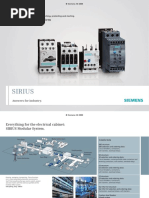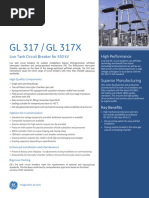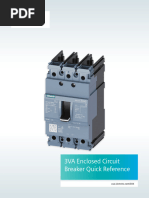Breaker Failure
Breaker Failure
Uploaded by
totyboyCopyright:
Available Formats
Breaker Failure
Breaker Failure
Uploaded by
totyboyCopyright
Available Formats
Share this document
Did you find this document useful?
Is this content inappropriate?
Copyright:
Available Formats
Breaker Failure
Breaker Failure
Uploaded by
totyboyCopyright:
Available Formats
13
Backup Protection
Revised by: E. D. PRICE
1 INTRODUCTION 2 REMOTE VS. LOCAL BACKUP
2.1 Remote Backup
Backup relaying, which provides necessary redun-
dancy in protective systems, is defined in the IEEE
Circuit breakers occasionally do fail to interrupt or trip
Standard Dictionary as ‘‘protection that operates
for various reasons, and the remote terminal relays and
independently of specified components in the primary
breakers may be able to provide backup for a failed
protective system and that is intended to operate if
breaker. A remote backup system is shown in
the primary protection fails or is temporarily out of
Figure 13-1. The relays protecting line GH at bus G
service.’’
for breaker 1 must also overreach and protect all other
Backup protection includes remote backup, local
lines extending from the remote bus H. That is, the
backup, and breaker-failure relaying. Breaker failure is
relays at G must operate selectively for faults on lines
defined as a failure of the breaker to open or interrupt
HR, HS, and HT if the relays or breaker 2, 3, or 4,
current when a trip signal is received.
respectively, fail to clear the associated line fault. Thus,
Backup protection for equipment such as genera-
the relays on breaker 1 provide primary protection for
tors, buses, and transformers usually duplicates
line GH, as well as backup protection for lines HR,
primary protection and is arranged to trip the same
HS, and HT. Backup systems use time discrimination
breakers. In the event of a breaker failure, some remote
to detect faults in the remote line sections.
line protection would isolate the fault.
In designing remote backup systems, their selectiv-
In the past, backup protection for transmission
ity, sensitivity, speed, and application must be con-
lines was provided by extending primary protection to
sidered.
line sections beyond the remote bus. This remote
backup is defined in the IEEE Dictionary as ‘‘backup
2.1.1 Selectivity
protection in which the protection is at a station or
stations other than that which has the primary Remote backup provides poor selectivity. It interrupts
protection.’’ all tapped loads on the unfaulted line sections. Open-
With the advent of EHV and increased concern ing breaker 1 at G for faults on a remote section may
about both service continuity and possible breaker interrupt service to tapped loads on line GH unne-
failures, local backup, including breaker-failure pro- cessarily. For a breaker failure at bus H, all lines
tection, has become common. feeding fault power through the defective breaker must
Copyright 2004 by Marcel Dekker, Inc. All Rights Reserved.
Figure 13-1 Remote backup at bus G, breaker 1 requires Figure 13-2 Remote backup at bus G, breaker 1 for line
these relays to selectively operate for faults on lines HR, HS, HR with inverse time overcurrent relays.
and HT under all operating conditions.
be opened at their remote ends with remote backup.
Such a scheme interrupts all loads on the lines, as well
as on bus H. Thus, if breaker 2 fails to open for a line
HR fault, breakers at G, S, and T must be opened with
remote backup.
2.1.2 Sensitivity
Remote backup provides poor sensitivity. Relays at
bus G may not ‘‘see’’ faults near buses R, S, or T. For
the scheme shown in Figure 13-1, the fault infeed effect
at bus H for faults near R, S, or T tends to reduce the
current magnitude and ‘‘reach’’ of distance relays at
breaker 1 at bus G. In these cases, relays at other Figure 13-3 Remote backup at bus G, breaker 1 for line
remote terminals will have to trip first, redistributing HR with distance relays.
the fault currents and increasing the effective reach of
the relays at bus G. This can result in sequential
tripping. 2.2. Local Backup and Breaker Failure
There are various reasons for a circuit breaker to fail to
2.1.3 Speed
interrupt or trip. The need for remote backup, local
Remote backup must be relatively slow to give the backup, or breaker-failure relaying depends on the
primary relays in the remote line time to clear their consequences of such failure.
fault (coordinating time interval in Figs.13-2 and 13-3).
As the coordinating time interval is typically 0.3 sec,
2.2.1 Local Backup
backup times greater than 20 cycles are common. If
sequential tripping is necessary, as indicated in the Unlike remote line protection, local backup is applied
preceding paragraph, the fault-clearing time for the at the local station. If the primary relays fail, local
breaker for a remote backup must be further increased. backup relays will trip the local breakers. If the local
breaker fails, either the primary or backup relays will
initiate the breaker-failure protection to trip other
2.1.4 Application
breakers adjacent to the failed breaker. Although local
The application and setting of relays for remote backup protection has many advantages and is widely
backup require an understanding of fault levels under used, it does not automatically eliminate the need for
all possible operating conditions. remote backup.
Copyright 2004 by Marcel Dekker, Inc. All Rights Reserved.
Local backup and breaker-failure protection are
characterized by fault detection and initiation of
tripping at the local terminal. For example, if a fault
on line HR (Fig. 13-1) is not properly cleared by the
primary protection system because of a failure in any
part of the system other than the circuit breaker, the
local secondary relaying system will detect the fault
and trip breaker 2. If the fault on line HR is not
properly cleared because of a failure of breaker 2, then
the primary and/or secondary protective relays will
initiate local breaker-failure backup to open breakers
3, 4, and 5 at bus H. Figure 13-4, a block diagram,
illustrates the difference between the remote backup,
local backup, and breaker-failure schemes.
A protection system involves a number of elements,
including protective relays; ac current transformers
and wiring; ac voltage transformers, devices, and
wiring; dc supply and wiring; circuit breakers or other Figure 13-5 Transmission line protection with maximum
disconnection means; and a communication channel practical redundancy.
with pilot relaying. Ideally, a backup protection system
should duplicate all these elements to provide total
redundancy. In practice, all elements except the circuit separate fuses leads are run from the voltage transfor-
breaker can be and frequently are duplicated in a mer to the relays.
variety of combinations, depending on the degree of Instantaneous relays can be considered an indepen-
protection required. The circuit breakers are not and dent protective system. Because these relays do not
cannot be duplicated. Many modern breakers have two fully cover the line section, however, a remote end-
independent trip coils, and breaker-failure protection zone fault would require an additional protection
provides a duplicate function. system. Local backup is usually applied only on lines
The maximum practical redundancy is separating equipped with a primary pilot system backed up by a
two protection systems as shown in Figure 13-5. The second pilot system or nonpilot backup relays, or both.
common element is the circuit breaker; even so,
separate trip coils are shown. If a common station
battery is used, separate fused leads from the battery
2.2.2 Basic Schematic and Operation
are used for the two protection systems. Quite
frequently, only one voltage source is used, and Figures 13-6 and 13-7 illustrate basic local backup and
breaker-failure schemes for electromechanical and
logic-based relays, respectively. The operating princi-
ple is the same for either scheme. In Figure 13-6,
operation of one of the protective relay systems trips
its associated breaker and energizes the breaker-failure
initiation relays 62X and/or 62Y, which are auxiliary
SG, MG-6, or AR types of relays. Contacts on 62X
and 62Y operate the timer 62BF only if the instanta-
neous overcurrent relay 50 indicates that current is
continuing to flow. This continued current flow,
indicating a failure to clear the fault, causes the timer
to energize the multicontact 86BF lockout relay,
tripping all the adjacent breakers. The 86BF lockout
relay may also be used to block reclosing, to stop the
Figure 13-4 Block diagram illustrating the differences carrier with blocking-type pilot relaying so that the
between remote backup, local backup, and breaker failure remote end can trip, if possible, and to initiate transfer-
schemes. trip.
Copyright 2004 by Marcel Dekker, Inc. All Rights Reserved.
Figure 13-8 Remote backup required with breaker failure
at station H where ring bus or breaker and a halfschemes are
used.
supervised by the breaker 52a contact to operate timer
62BF (Fig. 13-8).
The three overcurrent units (50) are normally
connected in phases A and C and to ground, but can
be connected in all three phases if necessary. The phase
units must be set below minimum fault current and can
be set below load current, if necessary. A setting above
load current is preferred in the interest of security if the
minimum phase-fault current substantially exceeds the
maximum load current. Setting above maximum load
Figure 13-6 Simplified dc protection schematic for breaker
helps to prevent undesirable tripping during testing.
failure and local backup protection. (Alternating current
circuit per Figures 13-5, 13-13, or 13-14.)
2.3 Applications Requiring Remote Backup with
Breaker-Failure Protection
Timer 62BF should be energized with device 50
(Fig. 13-6) rather than through the breaker auxiliary When ring buses or breaker-and-a-half schemes are
contacts 52a, since these contacts may be open, while used, breaker-failure protection does not necessarily
the contacts in a damaged breaker are closed. eliminate the need for remote backup: As shown in
Alternatively, breaker 52a contact can be used together Figure 13-8, a fault on line HR, for example, requires
with the 50 relay (Fig. 13-7). tripping both breakers 2 and 3 at station H. If breaker
Since transformer faults may not provide sufficient 2 fails to clear the fault, breaker failure would initiate
current to operate device 50, a transformer differential the tripping of breaker 5, but would leave line GH still
relay auxiliary contact 86T can be used instead, connected to the fault. The breaker-failure protection
for breaker 2 frequently initiates the transfer-tripping
of breaker 1 at station G. If transfer-trip is not applied
or is not operative, however, remote backup at breaker
1 is still required to clear the fault.
Because of the infeed effect and high apparent
impedances, remote backup from the remote stations
may be difficult, if not impossible, to achieve when all
lines are in service. Opening the breakers around the
failed breaker will, however, remove the infeed effect
and permit remote backup coverage. If, for example,
breaker 2 fails for a fault on line HR (Fig. 13-8), line
protection will open breaker 3 and breaker-failure
protection will open breaker 5 to remove all infeeds
Figure 13-7 Simplified logic diagram for logic-based around station H, except that from line GH.
breaker failure and local backup protection. (Alternating Breaker-failure protection would trip both breakers
current circuit per Figures 13-5, 13-13, or 13-14.) 5 and 6 upon the failure of breaker 4 for a line HS fault
Copyright 2004 by Marcel Dekker, Inc. All Rights Reserved.
(Fig. 13-8). Similarly, the failure of breaker 5 in 1. Its operating linkage is broken.
Figure 13-8 for a line GH fault would result in tripping 2. It is out of adjustment.
both breakers 4 and 6. All other breaker failure 3. The breaker mechanism has operated but the
conditions of breakers 4 or 5 would require remote main breaker contacts have failed to interrupt
backup, at S or G, respectively, or transfer-trip. the current.
When protective relays are being tested, the breaker-
failure scheme should be properly blocked or isolated to
prevent misoperation.
3 BREAKER-FAILURE RELAYING
APPLICATIONS
3.1 Single-Line/Single-Breaker Buses
Breaker-failure relaying should not be considered a
substitute for good system design and equipment A typical single-line/single-breaker bus is shown in
maintenance. Figure 13-9. Figures 13-10 and 13-11 illustrate the dc
Breaker-failure protection should be as fast as schematics or logic diagrams for breaker-failure/local
possible without tripping unnecessarily. This criterion backup protection using one timer per bus section.
is particularly important in EHV lines, where stability Figure 13-12 shows the schematic for one timer per
is critical. Here, breaker-failure timer settings of 100 breaker. The two methods, one timer per bus (method
to 250 msec (6.5 to 15 cycles on a 60-Hz basis) are 1) and one timer per breaker (method 2), have the
used. following differences:
These critical operations require dual high-speed
Method 1 is less costly than method 2, since fewer
solid-state or microprocessor pilot and breaker-failure
timers are required.
protections. With electromechanical-type relays,
breaker-failure timer settings of around 250 msec or
more are practical.
In applying breaker-failure protection, it is recom-
mended that
One breaker-failure circuit per breaker be applied,
regardless of the bus configuration.
All adjacent breakers should be tripped by breaker-
failure protection, regardless of fault location.
In all cases, all breakers tripped by the breaker-
failure scheme should be locked out.
A remote breaker must also be tripped by either its
own relays or transfer-trip initiated by local
breaker-failure protection. Remote backup clear-
ing of the breakers may be preferred over the
direct-transfer trip.
One timer per bus or one timer per breaker may be
used.
The latter is recommended, since it provides maximum
isolation and flexibility, even though it does involve
additional timers. These methods will be illustrated for
various bus arrangements.
Circuit-breaker auxiliary switches should not be
used to indicate whether or not a circuit breaker is
carrying current unless there is no other way to
accomplish this.
The fact that an auxiliary switch has operated is not Figure 13-9 A single-line single-breaker bus. (The breaker
sufficient proof that a circuit breaker has interrupted a failure local backup protective scheme is shown in Figures 13-
fault. The auxiliary switch may be opened because 10 and 13-11.)
Copyright 2004 by Marcel Dekker, Inc. All Rights Reserved.
Figure 13-10 Typical simplified dc schematic for breaker
failure local backup protection using a common timer for a Figure 13-12 Typical simplified dc schematic for breaker
single-line single-breaker bus of Figure 13-9. failure local backup protection using one timer per breaker
for the single-line single-breaker bus of Figure 13-9. (The
solid-state logic diagram would be as shown in Figure 13-7
for each breaker.)
Transfer-trip of the remote breaker is easier with
method 2. With method 1, the common timer
cannot distinguish which breaker has failed.
The common timer approach of method 1 requires
An evolving fault may cause incorrect breaker-
that the timer be set for the slowest breaker
failure operation with method 1. If a line 1 fault
interrupting time. Method 2 permits the separate
evolves to line 2, with sequential operation of
timers to be set for the interrupting times of the
62X, 62Y, and 50 contacts, the common timer
individual breakers.
circuit may be enrgized long enough to operate
and trip all breakers, even though both line 1 and
2 breakers trip normally. With method 2, each
3.2 Breaker-and-a-Half and Ring Buses
timer is deenergized as soon as the associated line
fault is cleared.
Typical breaker-and-a-half and ring buses are shown
in Figures 13-13 and 13-14. These arrangements
require tripping two breakers and paralleling the
current transformers for each line, as shown. A current
detector (50) is provided for each breaker. One timer
per breaker is recommended for all these bus config-
urations. Breaker-failure protection systems are shown
in Figures 13-6 and 13-7. Another set of 62X, 62Y
auxiliaries (shown dotted) must be added for the
second breaker.
The breaker-failure/local backup circuits are the
same for each breaker, except for the application of the
86 relay contacts. The 86BF relay operations are
outlined in Table 13-1 for Figure 13-13 and in Table 13-
2 for Figure 13-14. Neither table includes reclosing
Figure 13-11 Typical simplified logic diagram for breaker lookout, which may be desired.
failure local backup using a common timer for a single-line It will be noted from Tables 13-1 and 13-2 that all
single-breaker bus of Figure 13-9. adjacent breakers are tripped, regardless of fault
Copyright 2004 by Marcel Dekker, Inc. All Rights Reserved.
Table 13-1 Breaker-Failure Operations for Breaker-and-a-
Half Bus (Fig. 13-13)a
For local backup or
breaker failure no. 86 Relay operations
1 Trip 2 and all other bus breakers,
such as 4, etc., on bus L. Transfer-
trip line 1.
2 Trip 1 and 3. Transfer-trip lines 1 and
2.
3 Trip 2 and all other bus breakers,
such as 5, etc., on bus R. Transfer-
trip line 2.
a
See schematics for Figures 13-6 or 13-7.
Table 13-2 Breaker-Failure Operations for Ring Bus
(Figure 13-14)a
Figure 13-13 Single-line diagram of a breaker and a half
bus. For local backup or
breaker failure no. 86 Relay operations
location. For simplicity and reliability, breakers that 1 Trip 2 and 4. Transfer-trip line 1 and
are already tripped will be retripped. Assume, for 2.
example, that a fault occurs on line 1 of Figure 13-14. 2 Trip 1 and 3. Transfer-trip lines 2 and
The protective relays for line 1 will attempt to trip 3.
breakers 1 and 4 and the remote end of line 1. Assume 3 Trip 2, 4, and 5. Transfer-trip line 3.
4 Trip 1, 3, and 5. Transfer-trip line 1.
a
See schematics for Figures 13-6 or 13-7.
breaker 1 fails to clear, but breaker 4 and the remote
line 1 breaker do open. Then breaker failure need not
retrip 4 and transfer-trip line 1, as shown in Table 13-2.
Similarly, for a fault on line 2, it may be unnecessary to
retrip breaker 2 and transfer-trip line 2.
It is simpler, however, to trip all breakers involved,
and it also allows reclosing to be blocked throughout.
This practice also provides symmetrical protection
around the bus.
4 TRADITIONAL BREAKER-FAILURE SCHEME
4.1 Timing Characteristics of the Traditional
Breaker-Failure Scheme
Figures 13-6 and 13-7 show the approach of traditional
breaker-failure schemes. The operating principle of
this approach as illustrated in Figure 13-15 is that the
Figure 13-14 Single-line diagram of a ring bus. breaker-failure timer 62BF is started by the operations
Copyright 2004 by Marcel Dekker, Inc. All Rights Reserved.
base). Microprocessor timers are generally consistent
to within the computation interval time.
5. 62BF timer setting error. Includes human
error, instrumentation error, and potentiometer reso-
lution. The static timer may be set within 2 ms. The
microprocessor timer can generally be set to within the
resolution of the logic computation interval time.
Figure 13-15 Block diagram of the traditional breaker
failure scheme. 6. A safety factor. Because of the widespread
harmful effects of a false 86BF operation, it is
recommended that a generous safety factor be incor-
porated in the margin time. The degree of safety
of the fault detector 50 and the breaker failure initiates required is a direct function of the confidence level of
signal 62X or 62Y. the total protective system. Typical values range from
A time chart for the traditional breaker-failure two to six cycles (60-Hz base). A two-cycle safety
scheme is given in Figure 13-16. The shaded margin factor appears to be adequate, with three cycles being a
time provides security and should accommodate the widely used total ‘‘margin.’’
following variables:
1. Excessive breaker interrupting time. According
4.2 Traditional Breaker-Failure Relay
to ANSI Standard C37.04, the circuit-breaker inter-
Characteristics
rupting time may be one cycle longer for three-cycle
breakers at currents below 25% of the maximum
Four types of relays are used in the traditional breaker-
rating. Also, the interrupting time may be longer on
failure scheme: current-detector relays, timer relays,
close-open duty.
auxiliary relays, and multitrip auxiliary relays.
2. Inconsistency in BFI times. These are mini-
mized by static and microprocessor breaker-failure
4.2.1 Fault-Current Detector (50BF)
initiation. However, the wide time range associated
with electromechanical BFI is primarily a function of Fault detectors that have high dropout and whose
the variation in dc voltage. For example, the BFI AR dropout time is minimally affected by ct saturation and
contact output in the SRU relay or ARM module dc decay in the secondary circuit should be considered.
(Uniflex) has an operating time of 2 to 5 msec. The BFI Examples of this type are cylinder unit relays and static
telephone relay in the SRU relay has an operating time and microprocessor relays with suitable filtering.
of 8 to 16 msec. The SG relay 62X/62Y in the KC-4/ Hinged armature and plunger-type relays that can
TD-5 breaker-failure scheme has an operating time of have a significant dropout delay should be considered
16 to 50 msec. The breaker-failure total clearing time, carefully before use. If such devices are used, their
as shown in Figure 13-16, assumes that the pickup of dropout time could be ascertained under the worst
device 50 is equal to the protective relay plus the BFI conditions and this time should be considered when
time. Either 50 or BFI signal delaying will delay setting the breaker-failure timer. Determining the
starting the 62BF timer (Fig. 13-15) and the total worst condition may be difficult.
backup breaker-failure clearing time will be longer and A type KC-4 relay can be used for the fault-current
the margin increased. detector in an electromechanical breaker-failure
3. Overtravel of the 62BF timer after the fault scheme. It is a high-speed unit with a 98% or greater
detector reset. Static timers have less than 1 msec of ratio of dropout to pickup. The KC-4 relay has three-
overtravel. In microprocessor relays the overtravel cylinder-type overcurrent units in an FT case. It is
really depends on the logic and operation design. The available in 0.5- to 2.0-, 1- to 4-, 2- to 8-, 4- to 16-, 10-
overtravel is usually zero, but the worst case expected to 40-, and 20- to 80-A ranges. The pickup is
would be the computation interval time (the time approximately 19 to 24 msec at four times pickup
between logic calculations). current, and 12 to 16 msec at eight times pickup.
4. Inconsistency in 62BF timer. The static timer, Dropout times are on the order of 20 msec after the
as contained in the TD-5, TD-50, and SBFU, has a current decreases to 0. Various combinations of ranges
repeatability (including variations of ambient tempera- for phase and ground applications are available.
ture and voltage supply) of +5%, which is +5% msec Circuit shield types 50H and 50B are static relays
for a timer setting of 100 msec (six cycles on a 60-Hz with similar characteristics.
Copyright 2004 by Marcel Dekker, Inc. All Rights Reserved.
Figure 13-16 Time chart of the traditional breaker failure scheme (time not to scale).
4.2.2 Timer (62BF) 4.2.4 Multitrip and Lockout Auxiliary Relay
(86BF)
A direct-current static timer, type TD-5, is used in the
electromechanical scheme with contact input, as shown Either the electroswitch type WL relay or type LOR
in Figure 13-6. The range, for the breaker-failure can be used; their operating times are approximately
applications is 0.05 to 0.4 sec. Static timers, types 62B 16 msec.
and 62T are generally used with the static fault
detectors.
4.3 Microprocessor Relays
The microprocessor breaker-failure function is gener-
4.2.3 Auxiliary Relay (62X, 62Y, or BFI)
ally implemented in line relays in two levels. The first
Operating times are 16 to 50 msec for the SG and MG level provides only a breaker-failure initiate signal
relays, and 2 to 3 msec for the AR relays. (BFI, 62X, 62Y) simultaneously with the breaker trip.
Copyright 2004 by Marcel Dekker, Inc. All Rights Reserved.
In this case there is no 62X or 62Y operating time to when the arcing contacts open. The reset time of
consider. device 50 on such applications may be longer.
The second level is where the complete breaker- The fault-current level at which the unit is energized
failure tripping function is included in the line relay. prior to interruption.
Quite often special design considerations—filtering The setting of the unit.
and algorithms—are implemented to assure fast and Current transformer decay. When breaker current is
secure dropout of the 50-fault detector. These times interrupted at current zero, the current transfor-
will be specified and generally range from one-half to mer magnetizing current will not be zero. This
one cycle. It is generally safe to assume that the current would then have to decay through the
maximum dropout time will be one cycle plus the connected relays, possibly increasing their reset
computation interval time. That is, if the status of the time.
50-fault detector is computed every one-quarter cycle,
The reset time of a solid-state overcurrent relay is
then the maximum dropout time will be 1.25 cycles.
faster than an electromechanical one.
This assumes the appropriate dc filtering that is
expected in microprocessor relays.
The setting resolution of the 62BF timer will also be 5.1.2 Fault-Detector Setting Problem
defined by the computation interval time of the 50- Figure 13-17 illustrates a problem in the traditional
fault detector and the frequency with which the timer is breaker-failure scheme for breaker A on a ring bus
compared with the fault detector. application where maximum load exceeds minimum
fault levels. Because IF1 > IF2, it may be difficult to set
I < (IF2)/2 in the traditional single-fault-detector
scheme. One solution to this problem (Fig. 13-17) is
5 AN IMPROVED BREAKER-FAILURE SCHEME to use a special two-fault-detector breaker-failure
5.1 Problems in the Traditional Breaker-Failure scheme. The low set with 86T (from the transformer
Scheme differential scheme) is for a fault at F2, whereas the
high set with 62X (from the line protection) is for fault
5.1.1 Fault-Detector Reset Time Problem F1.
Referring to Figure 13-16, we see that the reset time of Figure 13-18 illustrates another problem in the
device 50 is a critical characteristic in the performance traditional breaker-failure scheme for breaker B in a
of the breaker-failure system. It will affect the margin breaker-and-a-half system application. If breaker B
value, as well as the 62BF timer setting. Device 50 fails for a traditional breaker-failure scheme, the 62BF
resetting stops the timer; with 62X/62Y seal-in, it is the timer for breaker B may not start (because initi-
only function that stops the timer. It should be noted al ¼ 10% may be lower than the fault-detector setting)
that the longer the reset time of device 50, the longer until breaker A opens (because sequential ¼ 100%).
the 62BF time has to be set. Consequently, it may be This condition results in unduly long backup clearing
difficult to set the timer securely and still avoid system time. One solution to this problem is to use a special
instability.
To prevent the device 50 reset time variables from
affecting the margin, it is recommended that the 62BF
time delay be determined for maximum device 50 reset
time. Any faster 50 reset will then merely add to the
safety margin.
The reset time of the overcurrent fault detector is
affected by several factors:
The reset times are longer when the current after
interruption is nonzero. Certain types of circuit
breakers are equipped with arcing contacts and
shunting resistors. When the breaker main
contact interrupts fault current, the current
does not drop immediately to 0, but to a level
determined by the shunting resistor. It falls to 0 Figure 13-17 Traditional BF scheme with two timers.
Copyright 2004 by Marcel Dekker, Inc. All Rights Reserved.
tripping occurs by the SPR and the breaker fails to
trip, breaker failure tripping occurs. The drawback is
that if the breaker trips successfully and the 52a
contact does not open, breaker failure clearing still
takes place.
5.2 The Improved Breaker-Failure Scheme
Many approaches have been devised for improving the
traditional breaker-failure scheme such as using a
shorter reset time of device 50 (for example, using a
Figure 13-18 Traditional BF with two timers and two fault static relay), or employing separate timers for different
detectors. levels of fault current. These approaches will still be
affected by the reset time of the device 50 and still
present difficulties in determining the reset time,
breaker-failure scheme as shown in Figure 13-18. It especially when information on the shunting resistor
includes two timers and two overcurrent units. How- current is not available.
ever, the shorter timer setting or lower overcurrent unit Figure 13-20 shows the basic concept of the
setting may affect the security of the traditional improved approach. The unique feature of this
breaker-failure scheme. approach is that the fault detector operates only after
These problems can be solved by applying the type the 62BF times out. By that time, the breaker-failure
SBF-1 breaker-failure relay. It uses an improved condition has been confirmed; consequently, the reset
concept as described in Section 5.2. time of the fault detector will have no effect on the
scheme. Figure 13-21 is the time chart for the improved
breaker-failure scheme.
5.1.3 Transformer Breaker-Failure
The improved approach has many advantages over
Considerations
the traditional ones:
A low-level fault internal to the transformer may cause
1. The fault detector 50 will not operate before the
the sudden pressure relay (SPR) to operate. The
62BF is timed out; therefore, it will never
current level may be well below a ‘‘low set’’ value
operate when clearing normally and device 50
that the overcurrent relay could detect. For this case,
reset time is not a consideration.
an 86T contact in series with the circuit breaker’s 52a 2. It permits shorter margin and shorter overall
(logically 86T AND 52a) as shown in Figure 13-19
clearing times and will wield a net saving of one
must be used to assert and start the timer. In this case if
to two cycles over the traditional approach.
This can be illustrated as below (compare Fig.
13-16 and 13-21): Net saving in clearing time -
¼ maximum 50 reset time, which represents
about one cycle for static units and two cycles
for electromechanical units.
3. The overcurrent-fault-detector unit never oper-
ates when clearing normally so it can be set
Figure 13-19 Transformer BF considerations. Figure 13-20 Logic diagram of the SBF-1 relay.
Copyright 2004 by Marcel Dekker, Inc. All Rights Reserved.
Figure 13-21 Time chart of the improved breaker failure scheme.
lower than load current, if necessary (for 5.3 Type SBF-1 Relay
example, application problems as described in
Section 5.1.2). The type SBF-1 breaker-failure relay uses the
improved concept for breaker-failure detection, as
described in Section 5.2. The relay, as shown in
Figure 13-16 Figure 13-21
Figure 13-22, consists of phase- and ground-fault
Total clearing time Total clearing time detectors, 62BF timer, and a ‘‘control’’ timer. The
¼ Protective relay time ¼ Protective relay time control timer is for resetting the SBF-1 relay. In
þ breaker interrupting time þ breaker interrupting time applying the SBF-1 relay:
þ maximum 50 reset time þ margin
þ margin þ 86BF time The fault detectors can be set below the load
þ 86BF time current.
Copyright 2004 by Marcel Dekker, Inc. All Rights Reserved.
Figure 13-22 Type SBF-1 relay.
Copyright 2004 by Marcel Dekker, Inc. All Rights Reserved.
The 62BF timer should be set longer than the Field experiences have shown it necessary to
breaker normal clearing time, with a margin of consider the consequences of the unsymmetrical
two to three cycles. operation of such a breaker. Electrical or mechanical
The control timer should be set at least 32 msec failures have left one phase open when the others are
longer than the 62BF time setting to provide long closed, and vice versa. Since pole disagreement may
enough time for the SBF-1 relay to trip the occur under a no-fault condition, the breaker-failure
breakers. The breakdown of this 32 msec is as initiation circuit of the conventional breaker-failure
follows (refer to Fig. 13-22): scheme may not be energized. Therefore, the conven-
8 tional breaker-failure relay scheme will not respond if
< RR relay 1 to 3 ms the failure occurs under a nonfault condition.
Maximum pickup of 50 unit 3 to 8 ms
: Figure 13-23 shows logic that can be used to detect
AR relay 2 to 5 ms pole disagreement under a no-fault condition. This
Total 16 ms logic has an output whenever one or more phases
86BF relay 16 ms carries current above the IH setting, while one or more
phases carries current below the IL setting. The current
Total 32 ms
inputs IL, IH, and IM must be capable of measuring
current accurately in the 1.0 to 100.0 mA range to
distinguish between no current and charging current.
This usually requires special current inputs to the relay.
6 OPEN CONDUCTOR AND BREAKER POLE For breaker-and-a-half or ring-bus configuration,
DISAGREEMENT PROTECTION with low-magnitude load current flowing through the
bus, odd phase current combinations result from
At voltages of 345 kV and above, the physical size of unequal phase impedances and multiple paths for
the operating components and the phase spacing current flow through the bus; unequal phase currents
requirements of power circuit breakers have led to flowing through an individual breaker can give the
the use of an independent operating mechanism for false appearance of pole disagreement. This logic
each. Also, with the trend toward larger and larger contains a zero sequence voltage comparison circuit
turbine-generator sizes, system stability criteria have (Fig. 13-23) that allows this low-current difference to
often dictated the use of independent pole-operated be ignored, while permitting tripping when a hazar-
breakers at voltages below 345 kV to obviate the three- dous pole disagreement actually exits.
phase fault, three-pole ‘‘hung’’ breaker fault condition. Simpler methods may be employed that utilize
Rarely will more than one fail to interrupt fault conventional ct inputs that are only reliable with
current. Therefore, serious faults (those involving two load flow. Typical minimum current levels that can be
or three phases) will always be downgraded if not accurately measured range from 0.25 to 0.5 A (250 to
entirely cleared, reducing the danger of system 500 mA). These applications involve the measurement
instability. of zero or negative sequence current through the poles
Figure 13-23 Pole disagreement logic example.
Copyright 2004 by Marcel Dekker, Inc. All Rights Reserved.
of the breaker, and may be used to trip or alarm. The The problem is that the unequal load current during
sequence current measured must distinguish between single phasing may pick up the ground overcurrent Io
that which is produced by normal unbalances and that unit (the phase overcurrent units may pick up also) in
produced by an open breaker pole. A long time delay is the conventional breaker-failure scheme (Fig. 13-24)
applied to ride through maximum fault clearing times. and trip the scheme falsely. One special arrangement,
as shown in Figure 13-24, has been employed success-
fully in the field for years for solving this problem. In
7 SPECIAL BREAKER-FAILURE SCHEME FOR this special arrangement, no ground overcurrent is
SINGLE-POLE TRIP SYSTEM APPLICATION used in the scheme. Each phase overcurrent unit is
supervised by its individual breaker-failure initiate
Special arrangements should be considered for a contact 62Z/A, B, and C. Blocking diodes TRB are
breaker-failure scheme in a single-pole trip application. used for blocking the sneak path during single phasing.
Figure 13-24 Special consideration on breaker failure scheme for single-pole trip application.
Copyright 2004 by Marcel Dekker, Inc. All Rights Reserved.
You might also like
- The Subtle Art of Not Giving a F*ck: A Counterintuitive Approach to Living a Good LifeFrom EverandThe Subtle Art of Not Giving a F*ck: A Counterintuitive Approach to Living a Good LifeRating: 4 out of 5 stars4/5 (6018)
- The Gifts of Imperfection: Let Go of Who You Think You're Supposed to Be and Embrace Who You AreFrom EverandThe Gifts of Imperfection: Let Go of Who You Think You're Supposed to Be and Embrace Who You AreRating: 4 out of 5 stars4/5 (1113)
- Never Split the Difference: Negotiating As If Your Life Depended On ItFrom EverandNever Split the Difference: Negotiating As If Your Life Depended On ItRating: 4.5 out of 5 stars4.5/5 (909)
- Hidden Figures: The American Dream and the Untold Story of the Black Women Mathematicians Who Helped Win the Space RaceFrom EverandHidden Figures: The American Dream and the Untold Story of the Black Women Mathematicians Who Helped Win the Space RaceRating: 4 out of 5 stars4/5 (937)
- Grit: The Power of Passion and PerseveranceFrom EverandGrit: The Power of Passion and PerseveranceRating: 4 out of 5 stars4/5 (619)
- Shoe Dog: A Memoir by the Creator of NikeFrom EverandShoe Dog: A Memoir by the Creator of NikeRating: 4.5 out of 5 stars4.5/5 (546)
- The Hard Thing About Hard Things: Building a Business When There Are No Easy AnswersFrom EverandThe Hard Thing About Hard Things: Building a Business When There Are No Easy AnswersRating: 4.5 out of 5 stars4.5/5 (358)
- Her Body and Other Parties: StoriesFrom EverandHer Body and Other Parties: StoriesRating: 4 out of 5 stars4/5 (831)
- Elon Musk: Tesla, SpaceX, and the Quest for a Fantastic FutureFrom EverandElon Musk: Tesla, SpaceX, and the Quest for a Fantastic FutureRating: 4.5 out of 5 stars4.5/5 (479)
- The Emperor of All Maladies: A Biography of CancerFrom EverandThe Emperor of All Maladies: A Biography of CancerRating: 4.5 out of 5 stars4.5/5 (275)
- The Little Book of Hygge: Danish Secrets to Happy LivingFrom EverandThe Little Book of Hygge: Danish Secrets to Happy LivingRating: 3.5 out of 5 stars3.5/5 (434)
- The World Is Flat 3.0: A Brief History of the Twenty-first CenturyFrom EverandThe World Is Flat 3.0: A Brief History of the Twenty-first CenturyRating: 3.5 out of 5 stars3.5/5 (2281)
- The Yellow House: A Memoir (2019 National Book Award Winner)From EverandThe Yellow House: A Memoir (2019 National Book Award Winner)Rating: 4 out of 5 stars4/5 (99)
- The Sympathizer: A Novel (Pulitzer Prize for Fiction)From EverandThe Sympathizer: A Novel (Pulitzer Prize for Fiction)Rating: 4.5 out of 5 stars4.5/5 (125)
- Devil in the Grove: Thurgood Marshall, the Groveland Boys, and the Dawn of a New AmericaFrom EverandDevil in the Grove: Thurgood Marshall, the Groveland Boys, and the Dawn of a New AmericaRating: 4.5 out of 5 stars4.5/5 (273)
- A Heartbreaking Work Of Staggering Genius: A Memoir Based on a True StoryFrom EverandA Heartbreaking Work Of Staggering Genius: A Memoir Based on a True StoryRating: 3.5 out of 5 stars3.5/5 (233)
- Team of Rivals: The Political Genius of Abraham LincolnFrom EverandTeam of Rivals: The Political Genius of Abraham LincolnRating: 4.5 out of 5 stars4.5/5 (235)
- On Fire: The (Burning) Case for a Green New DealFrom EverandOn Fire: The (Burning) Case for a Green New DealRating: 4 out of 5 stars4/5 (75)
- The Unwinding: An Inner History of the New AmericaFrom EverandThe Unwinding: An Inner History of the New AmericaRating: 4 out of 5 stars4/5 (45)
- SIRIUS Modular System PDFDocument32 pagesSIRIUS Modular System PDFarturoncNo ratings yet
- Medium Voltage Metal Clad Switchgear CatalogDocument24 pagesMedium Voltage Metal Clad Switchgear CatalogRobert John ToledoNo ratings yet
- Functional Test Kit InstructionsDocument20 pagesFunctional Test Kit InstructionsjorgemichelaNo ratings yet
- Basler 1051Document528 pagesBasler 1051pedromiguelsanchezNo ratings yet
- Commissioning Report For HTDocument50 pagesCommissioning Report For HTrstephenraj100% (9)
- Furnace Rectifier Trafos ABBDocument8 pagesFurnace Rectifier Trafos ABBvakilianmeNo ratings yet
- 499 Topics For Seminars Electrical and Electronics Engineering - Electrical Engineering PDFDocument11 pages499 Topics For Seminars Electrical and Electronics Engineering - Electrical Engineering PDFBaneeIshaqueKNo ratings yet
- Hyosung GisDocument24 pagesHyosung Gisamany moemenNo ratings yet
- Model DveDocument4 pagesModel DveAbduljabbarNo ratings yet
- Chapter6 PDFDocument38 pagesChapter6 PDFJaved LakanwalNo ratings yet
- SM6 SwitchgearDocument51 pagesSM6 SwitchgearAlvin Jan FranciscoNo ratings yet
- Eaton Panel PDFDocument84 pagesEaton Panel PDFGilQuintanaNo ratings yet
- 6.MF790C - Modbus Memory Mapping - 19-03-22Document76 pages6.MF790C - Modbus Memory Mapping - 19-03-22Raj GaneshNo ratings yet
- Lecture Notes: Converter ProtectionDocument59 pagesLecture Notes: Converter Protectionhareshacharya33860% (1)
- GL 317 / GL 317X: Grid SolutionsDocument2 pagesGL 317 / GL 317X: Grid SolutionsVinicius TadeuNo ratings yet
- Installing and Maintaining Panelboards: NECA 407-2009Document38 pagesInstalling and Maintaining Panelboards: NECA 407-2009Ahmed OmarNo ratings yet
- Chandraiah CV - DipDocument9 pagesChandraiah CV - DipLibin R SNo ratings yet
- Teknic PLN AP 2022Document56 pagesTeknic PLN AP 2022AV CorporatrionNo ratings yet
- MV Panel DiemensionsDocument32 pagesMV Panel DiemensionsM Umar ChatthaNo ratings yet
- Hil Patel Internship Final Report 7th SemDocument34 pagesHil Patel Internship Final Report 7th Semdkgaming0645No ratings yet
- 12K Manual 10 16 2019Document44 pages12K Manual 10 16 2019Luis SantiagoNo ratings yet
- PG4500iSR Manual eDocument25 pagesPG4500iSR Manual ePedro Francisco Hernandez MendozaNo ratings yet
- Agri Price List 01jan2019 PDFDocument32 pagesAgri Price List 01jan2019 PDFParas VaghasiyaNo ratings yet
- SEL-487E-3, - 4 Transformer Protection Relay: Three-Phase Transformer Protection, Automation, and Control SystemDocument4 pagesSEL-487E-3, - 4 Transformer Protection Relay: Three-Phase Transformer Protection, Automation, and Control Systemghostrider1098No ratings yet
- Final Doc: Specification For 12Kv Switchgear PanelsDocument16 pagesFinal Doc: Specification For 12Kv Switchgear Panelssunny_2502No ratings yet
- It ReportDocument49 pagesIt Reportspark instituteNo ratings yet
- Switch Gear ApplicationDocument230 pagesSwitch Gear Applicationapram singhNo ratings yet
- SV-Is5 Manual (English)Document205 pagesSV-Is5 Manual (English)sunhuynhNo ratings yet
- Sie FL 3va EnclosedcirbreakerDocument8 pagesSie FL 3va Enclosedcirbreakerirfan AlfiNo ratings yet
- Basic Electrical Terms and Definitions - E-Green ElectricalDocument5 pagesBasic Electrical Terms and Definitions - E-Green ElectricalJohn Florenz VasquezNo ratings yet






































































